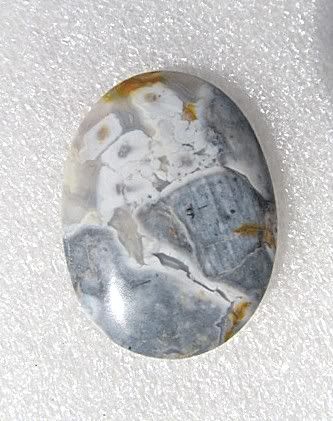dtcmor
freely admits to licking rocks
   Back to lickin' rocks again!
Back to lickin' rocks again!
Member since May 2006
Posts: 898
|
Post by dtcmor on Jun 20, 2011 13:03:09 GMT -5
I did some heat treatment experimenting with some of the material I brought back from Flint Rigde a couple of days ago. I used an old turkey roaster with an adjustable temperature control. It has a max setting of about 450deg., but by removing the cooking tray, I figured that I could get the temps up to almost 500deg. or a little hotter. From everything I have read about Flint Ridge, it takes temperatures between 500-675deg to get the colors to come out and to improve the knapping qualities. The reds, yellows and orange colors will appear at the lower temps, and the blues, purples and greens at the higher temps. I filled the roaster with alternating layers of spalls, flakes and thinner slabs, and sand in between to help absorb and disperse the heat evenly. I started the roaster at about 100deg and took it up slowly to max temp for the first 6 hours. Then, at max temp(about 500+deg.) I let them cook for about 12 hours, then shut it down to cool for another 6 hours. It was still hot enough that I needed gloves to dig the pieces out of the sand and see what had happened. The colors did pop out in most of the pieces, especially the reds, yellows and oranges. I also had a couple that popped the blue and purple as well, but no greens. I figure the temps must have reached about 550-600deg. for even these colors to come out, so in effect - this was a very successful first run. I might try a longer cooking time on the next run to see if it will turn the greens also. Here are a couple of pics of before and after to show the color change... These are raw to show the before.... 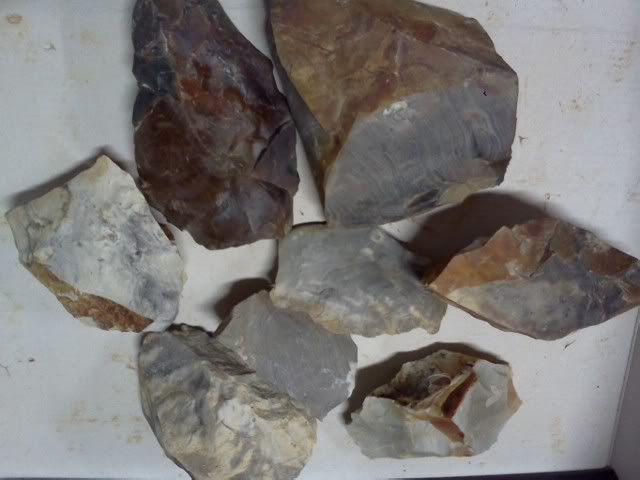 These are how they came out with the color change.... 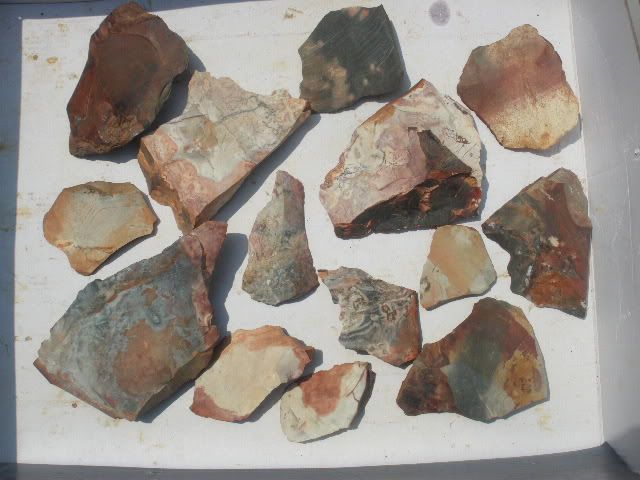 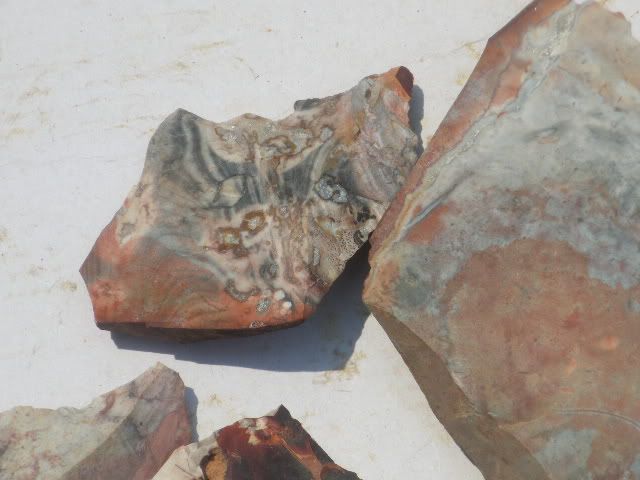 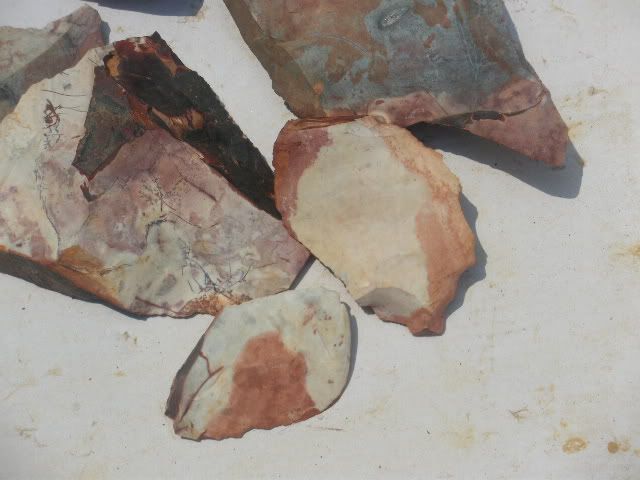 Thanks for looking! Dave |
|
meta99
has rocks in the head
   Ohio Flint Ridge flint
Ohio Flint Ridge flint
Member since October 2010
Posts: 540
|
Post by meta99 on Jun 20, 2011 16:41:01 GMT -5
Nice pics! Thanks for sharing. I have a kiln (from my pottery 'phase') so I'm thinking of trying to heat treat it there. My husband tried some in the wood stove this winter, but it didn't bring our much in the way of colors. If I ever get a round to it, I'll post pics. I still have cabs I've been working on all spring to finish and then photograph and then post...this is definitely a hobby that just keeps on going....
Sue
|
|
|
|
Post by Toad on Jun 20, 2011 17:26:36 GMT -5
Nicely done looking forward to seeing finished pieces.
|
|
|
|
Post by tanyafrench on Jun 20, 2011 18:24:27 GMT -5
Dave, it looks good. I tried it in my turkey roaster but it did not give that much change. Glad yours did.
Tanya
|
|
|
|
Post by jakesrocks on Jun 20, 2011 18:37:46 GMT -5
Hmmmmmmm, a friend is just getting ready to sell some lost wax casting equipment. Wonder if he has the burn out oven ? That should work good on flint.
Don
|
|
darstcreek77
has rocks in the head
  
Member since April 2011
Posts: 673
|
Post by darstcreek77 on Jun 20, 2011 21:08:43 GMT -5
if you put it in a dutch oven and built a mesquite wood fire under/over it would that bring out the color how long do you have to heat it ?
|
|
|
|
Post by Woodyrock on Jun 21, 2011 0:25:26 GMT -5
Darstcreek:
Early man heat treated flint, and other material to make knapping easier, and likely to bring out the colour as well. They dug a shallow pit about eight inches deep then laid the material in it bedded in clean dry sand. Then a fire was built over it and burned for a day. No material was removed until completely cool to touch. Today, some knappers use an old iron bath tub filled with dry builders sand in which they layer the rock, then build a fire on top. The tub is usually partially buried. The tub keeps the sand dry whilst not in use. a sheet of roofing tin makes a good cover. The DO filled with dry sand, and rock should work, but you would want it buried so it does not cool too fast.
Woody
|
|
dtcmor
freely admits to licking rocks
   Back to lickin' rocks again!
Back to lickin' rocks again!
Member since May 2006
Posts: 898
|
Post by dtcmor on Jun 21, 2011 9:28:51 GMT -5
Thanks all for the comments!  Tanya - How long did you cook yours for? For me it seems like the longer it stays at the max temp(about 500-550), the more defined the colors are. Even at 450deg., you should start to see the reds, yellows and oranges. You can also put them back in for another treatment again without doing any damage, because the turkey roasters do not quite reach the temps needed to change the properties of the stone completely. Also, the black and grey striped Nethers will not need much heat treatment, or none at all, and can be worked or knapped just like it comes out of the ground. Dartscreek - That method might work, but you have to start the temps out very low and build them up very slowly over hours until you reach max temps, then be able to maintain it for 12 - 24 hours, then a long cooling period. If you could do it like Woody described, it might work. Woody- Thanks for the description of the Ancient's methods! I have a small inground fire pit in my backyard, and have thought about trying it that way. The only problem is that I live in the city, and they are very strict about the no-burning rules. We have small 1-2 hour campfires occassionally, and the neighbors are pretty nice about it, but I don't think I could get away with doing a longer burn for the flint. |
|
Fossilman
Cave Dweller 
Member since January 2009
Posts: 20,723 
|
Post by Fossilman on Jun 21, 2011 10:44:16 GMT -5
I'm going to invest in a turkey roaster,my wife won't let me near her's....LOL
Great information all around..........
|
|
dtcmor
freely admits to licking rocks
   Back to lickin' rocks again!
Back to lickin' rocks again!
Member since May 2006
Posts: 898
|
Post by dtcmor on Jun 21, 2011 11:54:46 GMT -5
Fossilman - HaHaHa ;D...we have 3 different roasters,and I still had to beg my wife to let me use one of them. It really does a good job though!
|
|
jspencer
freely admits to licking rocks
  
Member since March 2011
Posts: 929
|
Post by jspencer on Jun 22, 2011 0:10:54 GMT -5
You guys have given me a thought of trying to heat treat some of the tons of flint we have available to us here in Texas. I recently saw a setup for sale on Craigslist, a hand built heater used for smelting ingots of aluminum and puring his own castings. It was powered by propane. I do my own lead smelting but only have a small pot and ladle so it won`t work on this. Thanks for the info too on the ways of the ancients. I detect an experiment coming up soon.
|
|
lparker
fully equipped rock polisher
   Still doing too much for being retired!
Still doing too much for being retired!
Member since March 2008
Posts: 1,202
|
Post by lparker on Jun 22, 2011 6:20:18 GMT -5
If you jump into heat treating without research you can end up in a heap of trouble...anywheres from material too brittle to work - to exploding kilns. For some kiln info - go to groups.yahoo.com/group/Knappers-R-Us/files/ and scroll down to "Kilns a-z" If you have Word, Excel, or Open Office, you can scroll down a bit further on the files page for heat treating rocks info. |
|
jspencer
freely admits to licking rocks
  
Member since March 2011
Posts: 929
|
Post by jspencer on Jun 22, 2011 23:35:43 GMT -5
Thanks lparker for that info. Yes I did know it could be a bad explosion without the proper ways. But with tons of sand, flint, and mesquite it could be done in a pit with all the fixins for free. Our flints polish up so easy because of the hardness that I have done some with 5 days in 220 and straight to 5 days of prepolish. They already look done before getting to 5 days of polish. The grey flint is really explosive and I have some of it I found with blueish streaks in its bands. I have only polished a small nodule of the grey and it came out fantastic but had cut it in half before polishing. We mostly have the colored flints which seem much harder. I have found many beautiful stones and am just now trying to learn to identify and polish well being a pretty much newbie to lapidary working. I appreciate all the help I can get.
|
|









